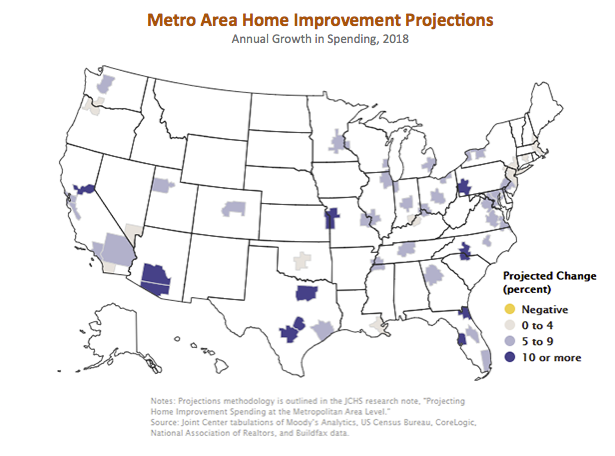Homeowners are expected to increase spending on improvement projects across the 50 largest U.S. metropolitan areas in 2018, according to the Metro Area Home Improvement Projects report. The report, released by the Remodeling Futures Program at the Joint Center for Housing Studies of Harvard University, indicates that homeowner spending will increase by at least 5% in 82% of the metro areas tracked.
All 50 of the tracked areas will have positive spending in 2018 while metro areas such as Kansas City, Charlotte, San Antonio, Dallas, and Sacramento are projected to have improvement spending increase by 10% or more, according to the report. The projections mirror the national projections from the Remodeling Future’s quarterly Leading Indicator of Remodeling Activity (LIRA), which predicts national spending on remodeling will increase by over 7% in 2018. Hanley Wood company Metrostudy also projected positive growth in the industry in its most recent Residential Remodeling Index (RRI)
The report’s projections show that growth in the remodeling market is not concentrated in one region geographically, Remodeling Futures Program Research Analyst Elizabeth La Jeunesse said in a news release from the Join Center of Housing Studies. Average growth through 2018 in metropolitan areas in the South, West, and Midwest are projected to be 7.4%, while growth in the Northeast is projected to be 5.6%, La Jeunesse indicated.
The Joint Center for Housing Studies’ annual Metro Area Home Improvement Projects attempts to provide a short-term outlook of home improvement to owner-occupied homes. The indicator used in the report is designed to project the annual rate of change in spending for the current quarter and subsequent four quarters. The report is intended to help identify future turning points in the business cycle of the home improvement industry.
“Spending growth is projected to be particularly strong in many of the nation’s more affordable markets,” says Chris Herbert, Managing Director of the Joint Center for Housing Studies. “At the same time, there are a few high cost markets where low housing supply is spurring the renovation of existing homes.”



